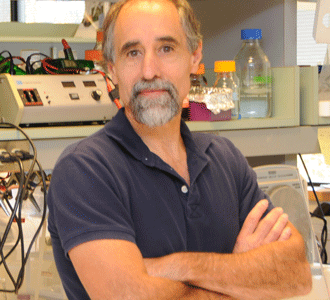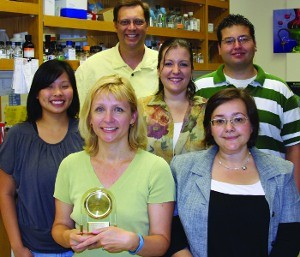With a $90,000 grant from FRAXA Research Foundation over 2 years, Dr. Michael Wilhelm and his team at the University of Wisconsin studied a protein known as JNK, which is observed to be abnormally regulated in Fragile X. Like FMRP, it is involved in regulating dendritic protein synthesis, and so it may be a target for drug therapy in Fragile X.
Read moreResearcher
Serotonergic Rescue of Synaptic Plasticity in FMR1 Knockout Mice

With $306,000 in grants from FRAXA Research Foundation, Dr. Julius Zhu from the University of Virginia examined the effects of several drugs such as Buspar and Abilify which manipulate specific serotonin receptors and the effect that has on synaptic plasticity (LTP and LTD).
Read moreEfficient Screening for Pharmaceutical Amelioration of FXS Behavioral Deficits in Drosophila

With a $112,250 grant from FRAXA Research Foundation over 3 years, Dr. Efthimios Skoulakis and his team from the Institute of Cellular and Developmental Biology conducted the first FRAXA project in Greece, where they developed a speedy new test for learning problems in fruit flies, which allowed them to test a number of drugs that are potential Fragile X treatments.
Read moreChannelopathies: Altered Ion Channels in Fragile X Syndrome

With a $95,000 grant from FRAXA Research Foundation from 2010-2011, Dr. Daniel Johnston and Dr. Darrin Brager at the University of Texas at Austin investigated alterations in ion channels in Fragile X syndrome. They explored potential therapeutic effects of drugs which open and close these channels. Results published.
Read moreRole of Excessive Protein Synthesis in the Ontogeny of FXS

With a $90,000 grant from FRAXA Research Foundation in 2010-2011, Dr. Mark Bear and Dr. Miquel Bosch tested the simple hypothesis that the excessive rate of protein synthesis is not a consequence but the primary cause of the structural alterations occurring in Fragile X syndrome.
Read moreAltered Dendritic Synthesis of Postsynaptic Scaffold Protein Shank1 in Fragile X Syndrome

With a $106,800 grant from FRAXA Research Foundation over 2 years, Drs. Stephan Kindler and Hans-Jurgen Kreieinkamp studied a protein, Shank1, which is overabundant in Fragile X syndrome.
Read moreClinical Trials Outcome Measures

With $281,824 in funding from FRAXA Research Foundation from 2002-2011, Dr. Berry-Kravis at the Rush University Medical Center attempted to validate a new automated video tracking system for quantifying physical activity as an outcome measure for Fragile X clinical trials.
Read moreManipulating Basal and mGluR-Stimulated cAMP Level in FXS Model Mice

With a $90,000 grant from FRAXA Research Foundation, Dr. Hongbing Wang’s team from Michigan State University looked at a treatment target “downstream” of the mGluR5 called cyclic AMP (cAMP). Levels of cAMP are lower in FXS patients and animal models, suggesting that it plays a role in FXS. Drugs that raise levels of cAMP may effectively treat Fragile X. We are very pleased to report that, in 2012, Dr. Wang received a 5-year, $250,000 per year R01 grant from NIH to continue this promising research.
Read moreGABAergic Inhibitory Function in Fragile X Syndrome

With a $100,000 grant from FRAXA Research Foundation, Drs. Joshua Corbin and Molly Huntsman from the Children’s National Medical Center examined the role of a particular class of brain cells (inhibitory interneurons) that dampen excessive activity in the “emotional center of the brain” (the amydala). This inhibition is deficient in Fragile X, and so they are looking for ways to remedy this. This is particularly interesting to parents of children who are overly anxious and emotional. They worked with Dr. Walter Kaufmann, a clinician at Kennedy Krieger Institute in Maryland.
Read moreCorrecting Fragile X Syndrome by Inhibiting the Synaptic RNA-Binding Protein CPEB1

The Richter lab is the foremost research group in the world in the study of CPEB, a protein critical for regulation of protein synthesis. With $170,000 in grants from FRAXA Research Foundation over 2008-2011, Dr. Joel Richter of the University of MA Medical School explored whether inhibitions of the CPEB may be a viable approach for treatment of Fragile X.
Read moreThe Slack Potassium Ion channel is a Therapeutic Target for Fragile X

With $282,000 in funding from FRAXA Research Foundation, Dr. Leonard Kaczmarek and colleagues explored association of Slack channels with the Fragile X protein (FMRP).
Read morePilot Clinical Trial of Lithium in Fragile X Shows Promising Results

With a $65,000 grant from FRAXA Research Foundation in 2005, Dr. Berry-Kravis at the Rush University Medical Center conducted a pilot clinical trial of lithium in 15 patients with Fragile X syndrome. Results published.
Read moreEncouraging Results from First Trial of Minocycline in Fragile X

With a $40,000 grant from FRAXA, Dr. Carlo Paribello and his team at the Surrey Place Centre Fragile X clinic in Toronto, Ontario, ran an open label trial to see if minocycline can improve learning and reduce anxiety and behavioral problems in people with Fragile X. Twenty participants between the ages of 13 and 35 years took minocycline for two months.
Read moreReactivation of the FMR1 Gene

With a $50,000 grant from FRAXA Research Foundation, Dr. Giovanni Neri and his team at Universita Cattolica del S. Cuore screened compounds with Neuropharm (UK) for reactivating compounds. This team is collaborating with Dr. Stephen Haggarty at Harvard and MIT (who also has a FRAXA grant), researching reactivation of the FMR1 gene and characterization of cell lines with unmethylated full mutations. Results published.
Read moreSmall Molecule Screen Using Fragile X Neural Stem Cells

With a $90,000 grant from FRAXA Research Foundation, Dr. Peng Jin’s team from Emory University School of Medicine found that Fragile X causes an increase production of new cells, so they tested large numbers of drugs to find those that can correct this. This high throughput drug screen uses neural stem cells from Fragile X knockout mice to identify small molecules which may be therapeutic in Fragile X.
Read moreNeuromotor Outcome Measures for Clinical Trials in Fragile X Syndrome

With a $35,000 grant from FRAXA Research Foundation, Dr. Nicole Tartaglia from the University of Colorado Denver and Tracey Stackhouse aimed to develop neuromotor outcome measures for use in clinical trials in FXS, and to contribute to a deeper understanding of the neuromotor issues involved in FXS. This collaborative project was completed at the two sites of the Colorado Fragile X Clinic: The Children’s Hospital and Developmental FX. Dr. Nicole Tartaglia is the Medical Director of the Fragile X Clinic at The Children’s Hospital of Denver. Tracy Murnan Stackhouse, MA, OTR is the co-founder of the Developmental & Fragile X Resource Centre (Developmental FX), a clinic specializing in Fragile X.
Read moreThe Role of FMRP and Small, Non-Coding RNAs in Translation

With a $120,000 grant from FRAXA Research Foundation, Drs. Henri Tiedge and Jun Zhong studied the mechanisms by which local protein translation is repressed. Multiple parallel mechanisms keep protein synthesis in check; one of them involves FMRP, and a similar mechanism involves the non-coding RNA, BC1. Results published.
Read moreSmall Molecule Modulators of Lithium for Treatment of Fragile X Syndrome

With a $219,500 grant from FRAXA Research Foundation, Dr. Stephen Haggarty from Havard/MIT developed a high-throughput drug screen to find compounds that inhibit GSK3, a critical enzyme in Fragile X. He looked for compounds that can accomplish this either alone or in combination with lithium, offering the possibility of enhancing the effectiveness of lithium as a treatment. His drug screen used patient-specific neural progenitor (NP) cells derived from human induced pluripotent stem cells (iPSCs) – which are created from cells in a skin biopsy from people with Fragile X syndrome (FXS) and other autism spectrum disorders.
Read moreAberrant Behavior Checklist in Fragile X Syndrome

With a $10,000 grant from FRAXA Research Foundation, Dr. Hessl at the University of California at Davis led a collaborative study to analyze the Aberrant Behavior Checklist (ABC) as an outcome measure for children and adults with Fragile X syndrome. Results published.
Read moreRole of the Cerebellum in the Dysfunction of Fragile X Syndrome

Correcting Fragile X Syndrome Deficits by Targeting Neonatal PKCε Signaling in the Brain Ben A. Oostra, PhD Principal Investigator Erasmus University Rotterdam, The Netherlands 2004-2005 Grant Funding: $119,000 Summary The Dutch-Belgian Fragile X Consortium led by Dr. Oostra created the
Read moreDeveloping Fragile X Treatments in Fruit Flies and Mice

With a $380,000 grant from FRAXA Research Foundation from 2005-2009, Drs. Sean McBride, Tom Jogens, and Catherine Choi studied one of the most important aspects of FRAXA’s research; the preclinical validation of potential therapeutic strategies. Many labs have found new leads for treatment. However, very few have the capacity to test new drugs in the mouse model to establish efficacy rigorously enough to lead to clinical trials. The McBride lab (in a broad collaboration with the Choi, Jongens, and Skoulakis groups) aims to do just that. Results published.
Read moreImaging Synaptic Structure and Function in Fragile X Mice

FRAXA Research Foundation grants $150,000 over 2005-2009 to Dr. Carlos Portera-Cailliau to study intact, anesthetized Fragile X mouse brains, looking for defects in the density, length, or dynamics of the dendrites. They looked for changes in the neurons after treatment with mGluR5 antagonists.
Read moreGenome-wide Epigenetic Markers in Fragile X

With $45,000 in grants from FRAXA Research Foundation over several years, Dr. Miklos Toth of Cornell University studied epigenetics (ie factors other than the gene itself) which can determine symptom severity in Fragile X.
Read moreMouse Models of Fragile X Syndrome

Dr. Ben Oostra and his team at Erasmus University completed and published multiple studies related to Fragile X syndrome. They created the first Fragile X knockout mouse model and went on to perform many critical studies in Fragile X mouse models.
Read moreRole of Matrix Metalloproteinases (MMP-9) in Fragile X

With a $220,000 grant from FRAXA Research Foundation over 3 years, Dr. Iryna Ethell from the University of California at Riverside studied the regulation of dendritic structure by matrix metalloproteinases and other extracellular signaling pathways. This work identified a major treatment strategy for Fragile X with the available MMP-9 inhibitor, minocycline.
Read more
